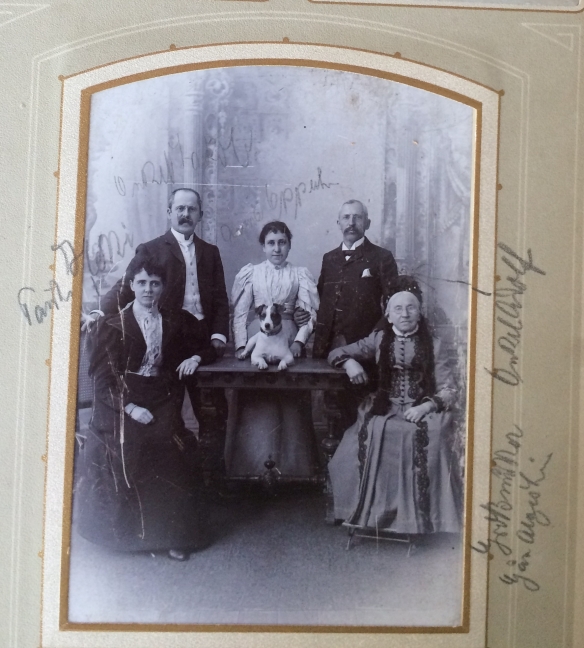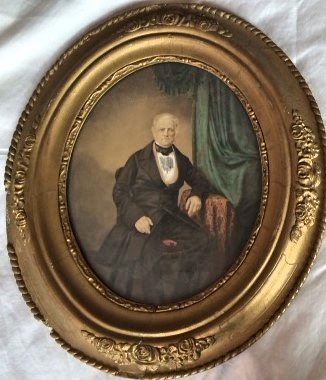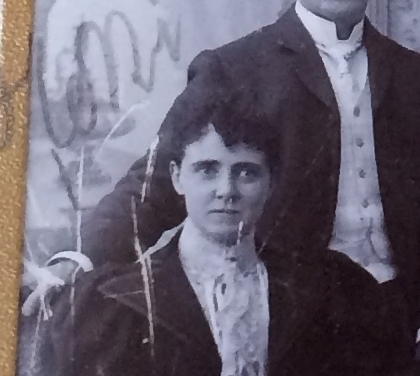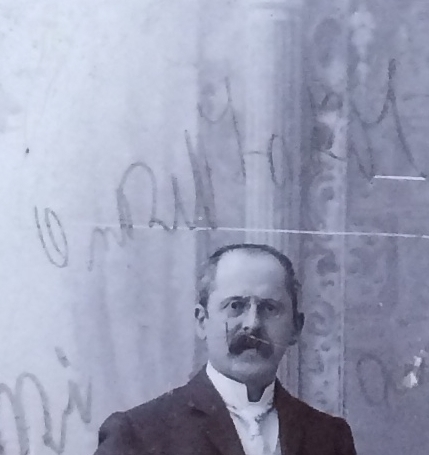Sometimes you need to hire an expert to help with hard questions. With the help of the genealogy village—my fellow bloggers and the members of the various Facebook groups and JewishGen—I have been able to find and learn more than I ever imagined. But when it came to some of those mystery photos that bewildered and frustrated me, I decided it was time to find an expert, and the expert who came highly recommended—for good reason—is Ava Cohn, a/k/a Sherlock Cohn, the Photo Genealogist.
I had originally sent Ava this photo of my grandfather Isadore Goldschlager because I was curious about identifying the other people in the photograph.
But Ava and I discussed it, and she concluded that without more information and more photographs, it would be impossible to make much progress identifying total strangers who lived over a hundred years ago. I really appreciated Ava’s honesty, and when she asked if I had any other photographs that might be more amenable to her analysis, I looked back to consider some other options.
I sent her this photograph from Fred Michel’s album, which I had discussed here and here and here, but about which I remained somewhat mystified.
I had concluded tentatively from my own analysis and comparison to other photographs and the inscriptions on the photograph that the older woman was probably my three-times great-grandmother Babetta Schoenfeld Seligmann, and the two men labeled Onkel Adolf and Onkel Jakob were probably Babetta’s sons, Adolf and James, brothers of my great-great grandfather Bernard Seligman. Adolf, like my great-great-grandfather Bernard, had left Germany and settled in Santa Fe, New Mexico, and James had moved to Great Britain. I had learned that James was not a common name for boys in Germany in the 19th century so it was likely that he was born Jakob and adopted the name James after emigrating. Also, my cousin Lotte, who had met James Seligman when she was a young girl, thought that “Onkel Jakob” resembled the man she remembered as James Seligman.
But I was not at all sure who the two younger women were, especially the woman to the left in the photograph. I’d asked on the blog if anyone could read the inscription near her picture, but no one was certain what it said. The woman in the center appeared to be labeled Anna Oppenheimer, but I couldn’t understand why she would be in the photo. Anna Oppenheimer was the daughter of Pauline Seligmann and Maier Oppenheimer and the granddaughter of Babetta. But why of all the grandchildren would only she be in this photograph, especially since her mother was not included, just two of her uncles?
Ava studied the photograph as well as my blog posts, my family tree for the Seligmann family, and other photographs of the Seligmann family, and then sent me a detailed and thorough analysis of her own conclusions, which I found well-founded, fascinating, and persuasive. With her permission, I am sharing some of her report.
I thought Ava’s analysis of the overall relationships among those in the photograph based on traditional posing in studio photographs of families was quite interesting:
In the mystery photograph, the family is posed in a typical family grouping of five individuals seated and standing around a large library table upon which is a dog, perhaps the family pet. The photo has been taken in a photographer’s studio with an appropriate backdrop for the time period. The two individuals on the left hand side appear to be a married couple while the elderly woman seated on the right could be mother or grandmother to one or more of the individuals in the photo. The man on the right, probably a son and the young woman in the center holding the dog could be related but are not married to each other.
Ava concluded that the photograph was taken in 1896-1897. Here is part of the reasoning for her conclusion:
To establish a year for the photograph, I looked at the clothing worn. Since what we know of the family’s comfortable economic status, it is logical that they are wearing up-to-date fashions, for the most part. The elderly woman, as is customary for many older women, is not as fashionable as the two younger women. Her dress, with multiple small buttons down the bodice, is a typical style of the 1880s as is her bonnet. The other two women are wearing clothing from the latter half of the1890s, post 1895. By this point in time the enormous leg-o-mutton sleeves of the 1893-1895 time period have become less full with the vestige of fullness above the elbow. The man on the left is wearing a high Imperial collar, common in the 1890s.
Ava agreed that it was reasonable to conclude that the elderly woman labeled “Grossmutter Gau Algesheim” was Babetta Schoenfeld Seligmann and that the man on the right, labeled Onkel Adolf, was her son Adolf Seligman, brother of Bernard and a resident of Santa Fe in the 1890s. At that time Adolf was in his fifties (born in 1843) and unmarried. Ava thought that the man labeled Onkel Adolf in the photo appeared to be in his mid-fifties. Ava did not think the woman in the center was Adolf’s wife, Lucy, since Lucy would have been only about fourteen in the mid-1890s and did not marry Adolf until 1902.
Rather, Ava opined that the woman in the center was in fact Anna Oppenheimer as labeled. She would have been nineteen or twenty in 1896-1897:
It appears that she is wearing a wedding or engagement ring in the photograph. The writer of the inscription has used Anna’s maiden name, Oppenheimer, as opposed to her married name, Anna Kaufman, so, along with the absence of Max Kaufman in the photograph, I believe that this photo was taken before her marriage to Max. Again, having a marriage certificate for Anna and Max could confirm why the writer used Anna’s maiden name here instead of her married name.
Unfortunately, I do not have a marriage record for Anna, and there is no record of any children born to her and her husband Max Kaufman so it is impossible to determine when exactly they married.
That left the two remaining people in the photograph: Onkel Jakob and the woman sitting on the left side of the picture whose name I could not decipher in the inscription. Ava agreed that “Onkel Jakob” was James Seligman. So who was the other woman?
Ava believes that she was James/Jakob Seligman’s wife, Henrietta Walker Templeton, who was born in England in 1866 and married James Seligman in London in October 1887. Ava read the inscription next to the woman to be “Tante Heni:”
Heni is a nickname for Henrietta and clearly shows the relationship with the writer of the inscription because of the informal use of a nickname. Tante (Aunt) could be one by marriage not necessarily by blood. In the mystery photo Heni appears to be about age 30-31.
In addition, Ava interpreted the posing as indicative of a marital relationship between Jakob and the woman seated in front of him, saying, “The manner in which he is posed with his arm around the back of Heni’s chair suggests their relationship.”
This made perfect sense to me. Ava speculated that perhaps James and Henrietta had come to Gau-Algesheim to celebrate their tenth anniversary with the Seligmann family, which would have been in 1897. I also recalled that Lotte had mentioned in an email dated July 6, 2015, that James and his English wife (whom Lotte referred to as Hedy) had visited “the continent” once. Lotte was born in 1921, so would not remember a visit in the 1890s, but the fact that James and his wife visited during Lotte’s lifetime in Germany makes it even more likely that they had in fact visited on earlier occasions. Lotte also said that James returned after Henrietta’s death in 1928.
Ava even analyzed the dog in the photo.
Given that the same dog appears in both the mystery photograph and the one of Bettina Arnfeld nee Seligmann (born 1875), I thought I’d include that here. It is clearly the same dog. I had considered that the dog may have belonged to the photographer but given how calm he/she appears in the photographs, I believe he was a family pet. The photo of Bettina was taken roughly 3 years after this one, circa 1900. The photo of Bettina may have been an engagement picture as she and Adolf Arnfeld married in 1900.
Bettina Seligmann Arnfeld was the daughter of Hyronimus Seligmann, Babetta’s son and brother of Bernard, Adolf, and James, among others. She was Anna Oppenheimer’s first cousin. So whose dog was it? Certainly not James or Adolf since neither lived in Germany. Perhaps the dog belonged to Babetta? She is the only common link between the two young women pictured with the dog. Babetta died 1899; if Ava is correct and the photograph of Bettina was taken in 1900, perhaps Bettina inherited the dog from her grandmother?
I was quite satisfied and persuaded by Ava’s analysis of the family photograph. But she didn’t stop there. I had also supplied her with additional photographs to help with her analysis of the family photograph. For example, I sent her this one, which I believed was a photograph of Babetta as a young woman.
I had based that conclusion on the fact that another photograph that I paired with the one of the woman was labeled Grossvatter and thus presumably was my three-times great-grandfather Moritz Seligmann.
But Ava disagreed about the identity of the young woman:
I did a comparison of the older photograph of a young woman that you supplied. This photograph is roughly dated circa 1859-1861 based on clothing and hairstyle as well as the type of image, most probably a daguerreotype popular in the 1850s and very early 1860s. The young woman appears to be in her teens and no more than 20 years of age. This eliminates the possibility that this earlier likeness is Babetta who would have been 49-51 years old. But there is a possibility given the provenance of the photograph and the resemblance to Babetta that this is one of her daughters, Pauline or Mathilde. It is unlikely to be her niece/stepdaughter, Caroline. Given that the photo was obtained from the Michel descendants, Pauline is the most likely candidate. Further research, documentation and comparison photographs would be needed to make a positive identification.
Although I was quite disappointed to think that this was not Babetta, the more I considered Ava’s analysis and the more I looked at the photograph of the young woman and the one of Moritz, the more I realized my error. The frames on the two photographs are quite different as is the style and the posing. I had just jumped to the conclusion that because Suzanne had sent these two photographs in the same email that they were of a couple. That’s why sometimes you need to hire an expert!
Finally, Ava also did an analysis of the wonderful photograph that my cousin Davita had sent of a man she said was her grandfather, Adolf Seligman, and his favorite sister, Minnie, riding camels in Egypt:
I was quite surprised but also persuaded by what Ava had to say about the identity of the people in this photograph; she is quite certain that the woman is in fact Henrietta Walker Templeton, and the more I studied the photograph, the more I agreed.
The Egypt photo is roughly dated based on her suit and hat as being taken in 1910. That would make Heni 44 years old. Her face has aged from the earlier photo and she’s put on a bit of weight, not uncommon approaching middle age. She is very stylish in the 1897 photo and likewise in the 1910 one. In both, she has chosen an up-to-date suit rather than a dress. Her dark hair is the same style. Notice the “dip” in her bangs on the right side of her forehead. It’s the same as the earlier photo. Her eyebrows, nose and mouth are the same as is the overall attitude captured by the photographer.
After I read Ava’s comment, I checked the emails that Lotte had sent me and saw that she had described James’ wife as “big and pompous.” The woman Ava concluded was Henrietta certainly does have a certain air of superiority in both of the photographs.
Also, I have absolutely no record of any kind supporting the existence of a Seligmann sister named Minnie, so already had had questions about Davita’s description. Thus, I was open to the idea that it was not Minnie, but someone else. I hadn’t considered Henrietta since I believed that the man was Adolf, as Davita said. Why would Henrietta from England be riding a camel in Egypt with her brother-in-law Adolf, who lived in Santa Fe?
But Ava raised a question as to whether this was in fact Adolf. If the photograph was taken in 1910, why would Adolf, who had married in 1902 and had three children by 1910, be traveling to Egypt? The more I looked at the earlier photographs of Adolf and Jakob/James, the more I became convinced that the man on the camel is in fact James, not Adolf. Ava also agreed that it seems quite likely that it is James, not Adolf, in the photograph, but that without more information, we can’t be entirely sure, especially since Davita, the source of the Egypt photograph, believed that it was her grandfather Adolf. (Adolf died before Davita was born, so she had never met him in person and only had this one photograph that she had been told was of her grandfather.)
Thus, although without more photographs and/or records we cannot be 100% certain, I am persuaded that Ava’s conclusions are correct about the likely identities of the people in the group photograph, the portrait of the young woman, and the Egypt photograph.
It was well worth the fee I paid to have the benefit of Ava’s expertise. I highly recommend her to anyone who has questions about an old photograph. If you are interested, you can email Ava at Sherlock.cohn@comcast.net or check out her website at http://sherlockcohn.com/ You will probably have to wait quite a while because her services are very much in demand and she devotes a great deal of time to each project, but it will be worth the wait.
[I was not paid or required by my contract with Ava to advertise her services; I am writing this blog post as a service to others who might be interested.]
.














Very interesting questions/answers ….
1. Bettina Arnfeld nee Seligmann
same Person? Bettina Seligmann Arnold was the daughter of Hyronimus Seligmann,…
2. I agree, probably James Seligmann
LikeLiked by 1 person
Ooops—typo—Thanks!!
LikeLike
It was so interesting to read about the details she picked out to help identify people and date the photographs. Great post Amy.
LikeLiked by 1 person
Thanks, Cathy!
LikeLiked by 1 person
This is fascinating. One of my cousins married an Oppenheim. Are the Oppenheims interchangeable with the Oppenheimers?
LikeLiked by 1 person
I don’t think so. I think they are two different names. But perhaps some people shortened it??
LikeLike
Oppenheim is a small old town on the Rhine,
http://www.jewishencyclopedia.com/articles/11723-oppenheim
The name was chosen as a last name by many Jews, both with and without the ending “er”, Some became famous:
https://de.wikipedia.org/wiki/Moritz_Daniel_Oppenheim;
Julius Robert Oppenheimer
LikeLiked by 1 person
Thanks, Dorothee, for the clarification.
LikeLike
Fascinating blog post! I love photo-genealogy/sleuthing, and often use it in my hobby. Read your/Eva’s analysis of the photos, and I agree completely. The inscription says “Tanti Heni”…the woman on the camel is Henrietta…and she does appear to have a look of “hocknasige” superiority about her. Perhaps that (attitude) lead to her passing away due to “obscure” tummy trouble?
Thanks for sharing Ava’s contact info! I may use her someday on a photo I’m stumped on.
Chip
p.s. And also agree; the man on the camel is almost certainly Jacob.
LikeLiked by 1 person
Thank you, Chip! I am glad you found it interesting and also that you agree with Ava and me. The more affirmations, the better! 🙂
LikeLike
This is fascinating. It’s wonderful how a fresh pair of eyes — especially “trained” eyes, can read so much more from an image.
LikeLike
I agree. Once I saw what she saw, it all made sense to me.
LikeLiked by 1 person
Great post, Amy. It’s like taking a nature tour with a really experienced guide–without one, you don’t notice anything unusual. With one, the landscape comes alive and you don’t ever look at it the same way again.
LikeLiked by 1 person
Exactly, or like going to a museum with a guide as opposed to without.
LikeLiked by 1 person
This sleuthing with Ava really paid off for you, Amy! I agree with her statements, but until her points of reference, I too would be confused. You found a real gem to help you. And I love that the Jack Russell Terrier is included as part of the family in the photos. That seems so modern!
LikeLike
It really was worth it to get that trained pair of eyes. And being an animal lover, I also loved that the dog was included. It made me think that my love of animals might be encoded in my Seligmann DNA!
LikeLiked by 1 person
This was a positively fascinating post Amy! I kept scrolling back and forth to look at the photos again and again. 🙂 I still can’t get over the photo taken in Egypt – it’s so cool!
There is an unidentified couple, presumably married, in several of my old family photos. You’ve inspired me to seek the advice of a professional to determine their identities. Thanks for the gentle nudge!
LikeLiked by 1 person
Thank you, Laura! I highly recommend Ava. Feel free to contact me if you have questions.
LikeLike
Wow! It is amazing what a professional can figure out from a photo. Sometimes we are so close to it we just want it to be a particular person – a fresh set of eyes definitely helped!
LikeLiked by 1 person
Yes, it definitely was worth the money. Every time I now see people posting photos asking things like Are these two of the same person? or When was this taken? I want to say, “Ask Ava!”
LikeLike
Pingback: Abraham Katz Moves to Oklahoma | Brotmanblog: A Family Journey
Pingback: Cohen and Company Photograph: Is That My Grandfather? | Brotmanblog: A Family Journey
Pingback: Cohens on the Beach: Another Case for Sherlock Cohn, The Photogenealogist | Brotmanblog: A Family Journey